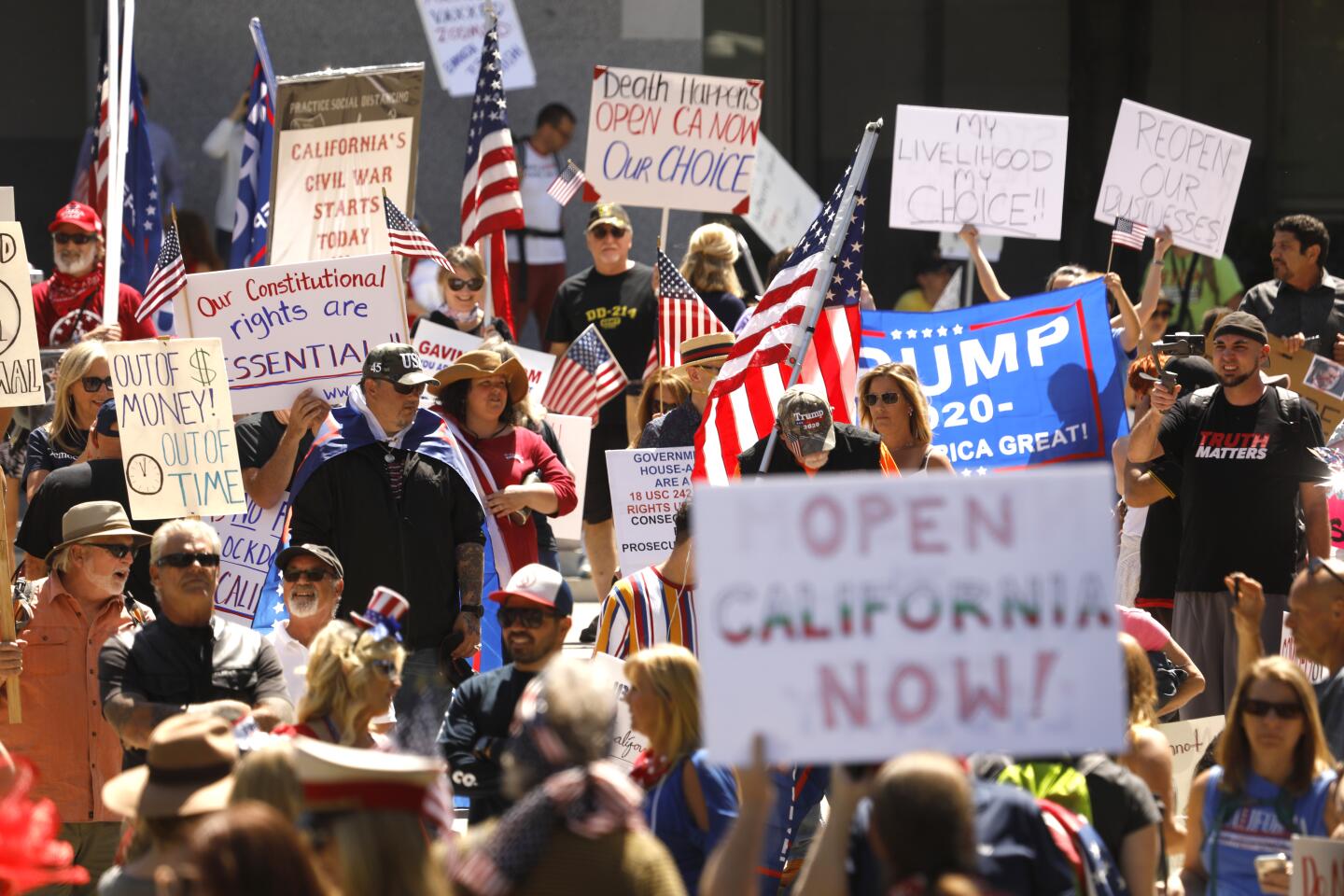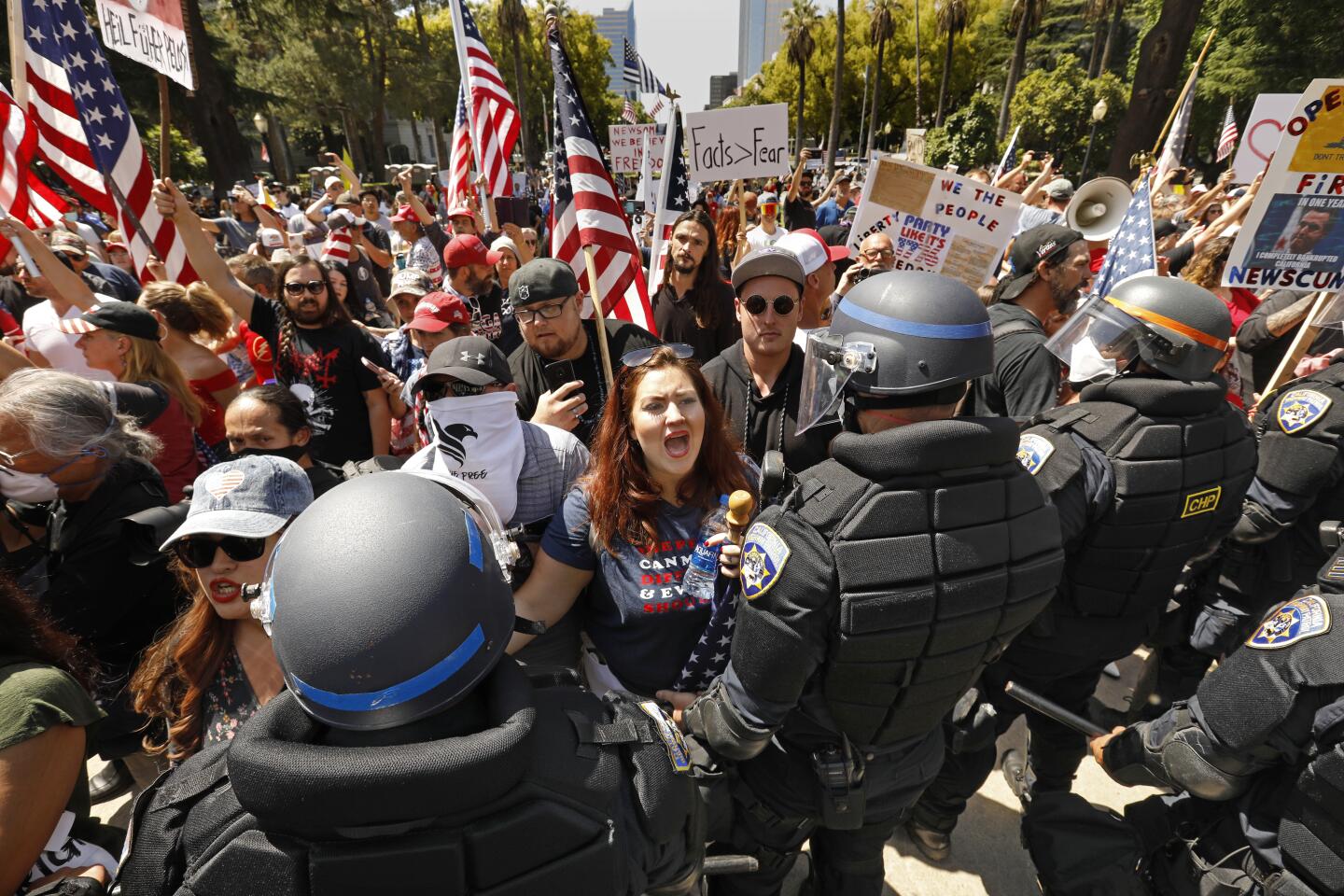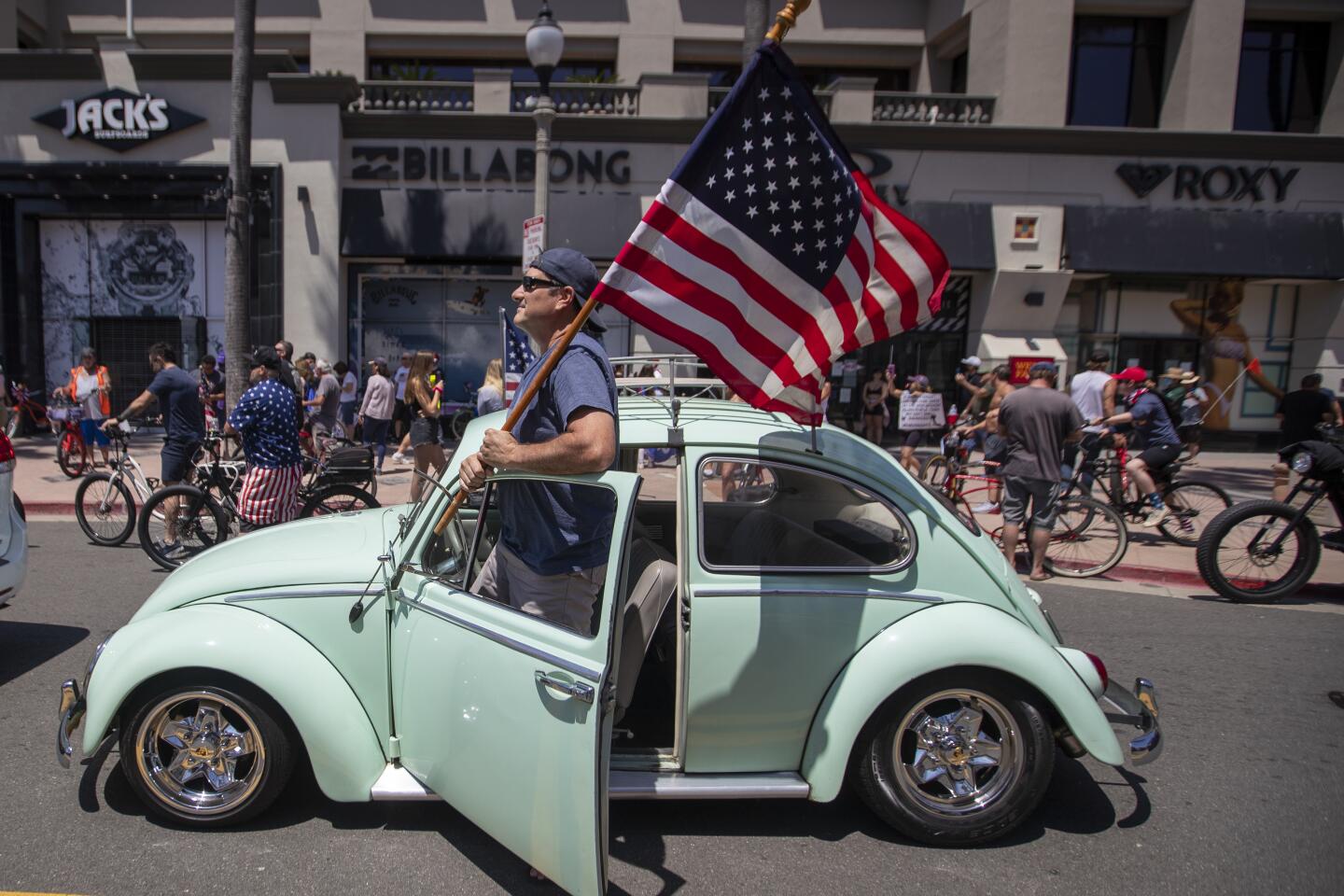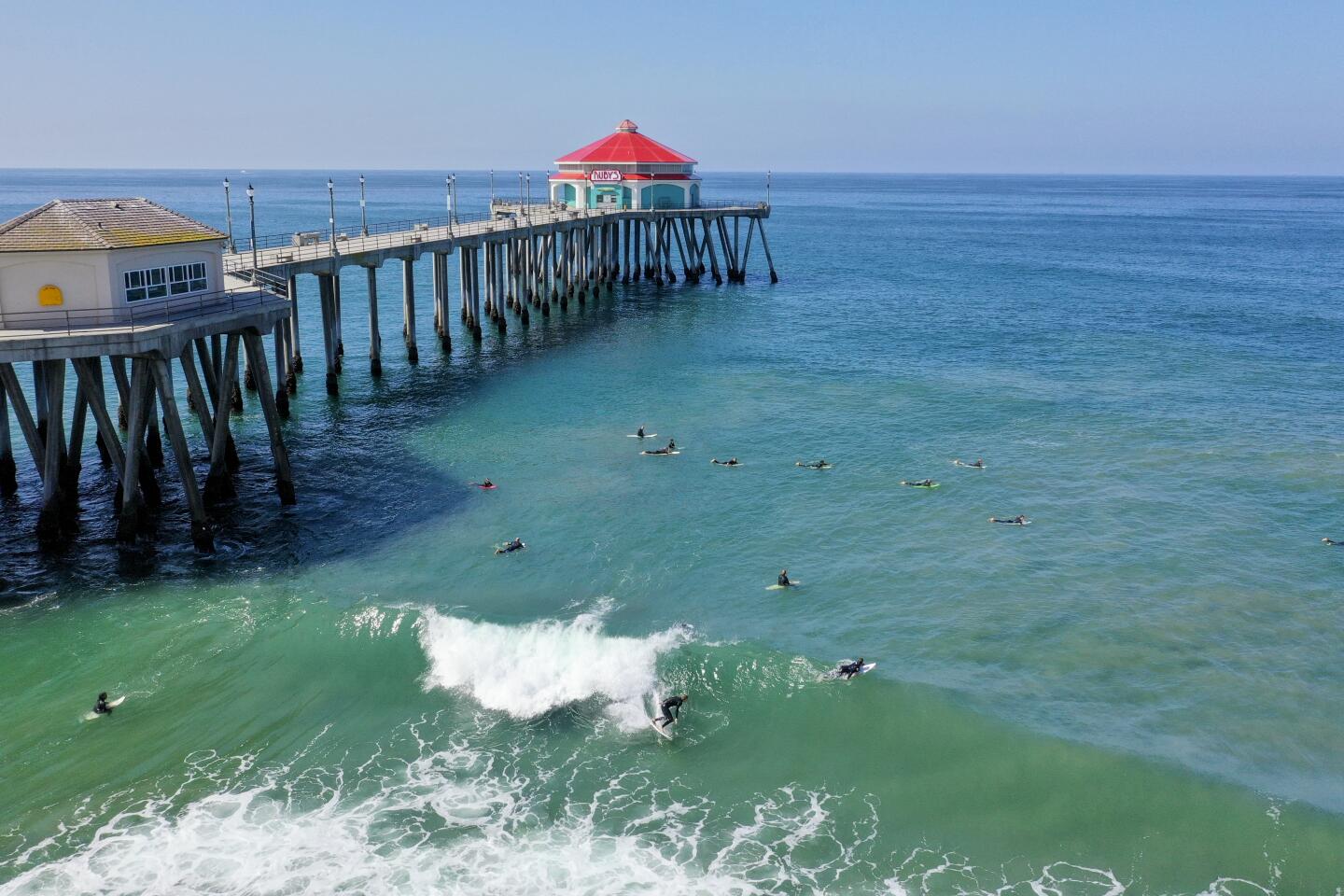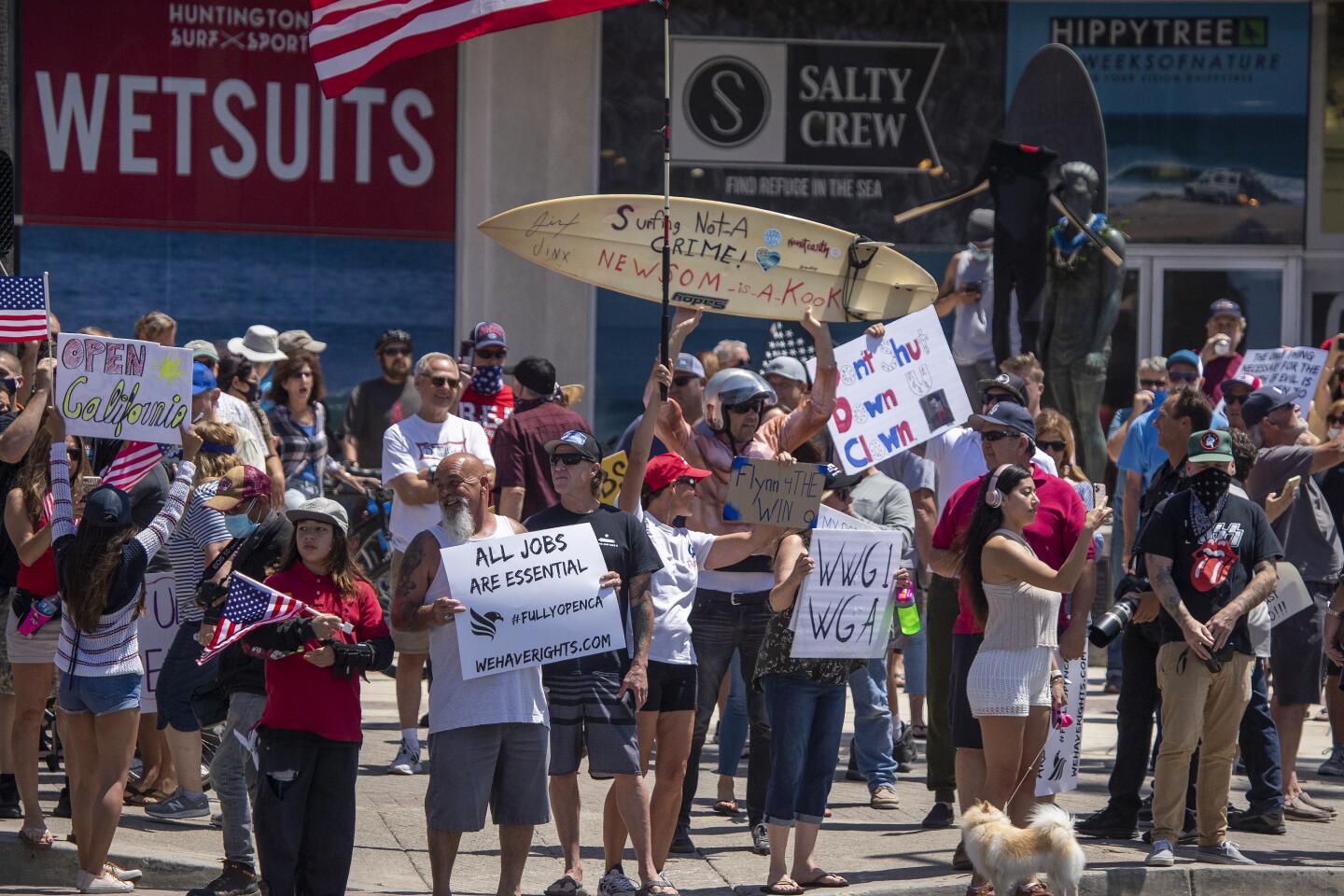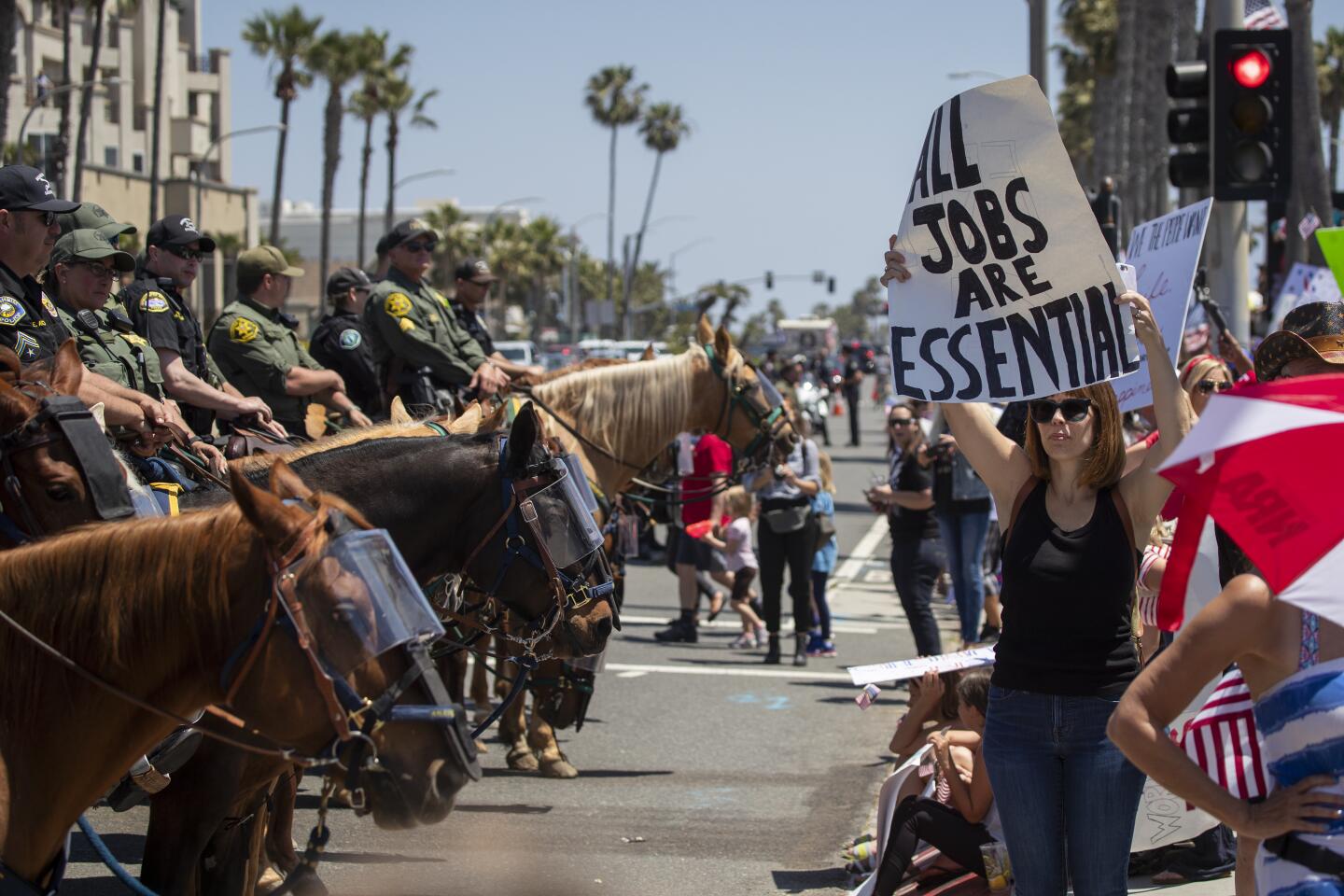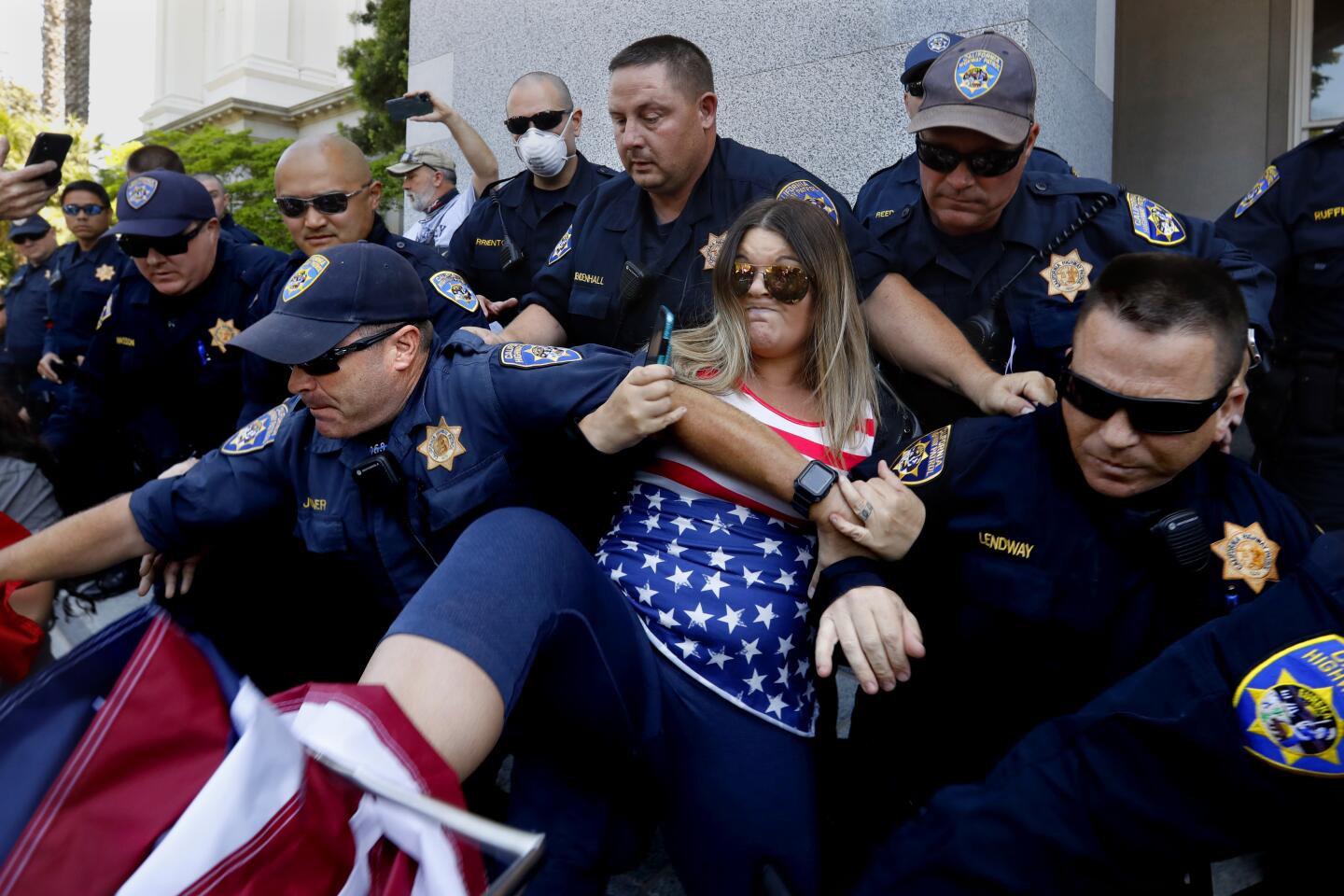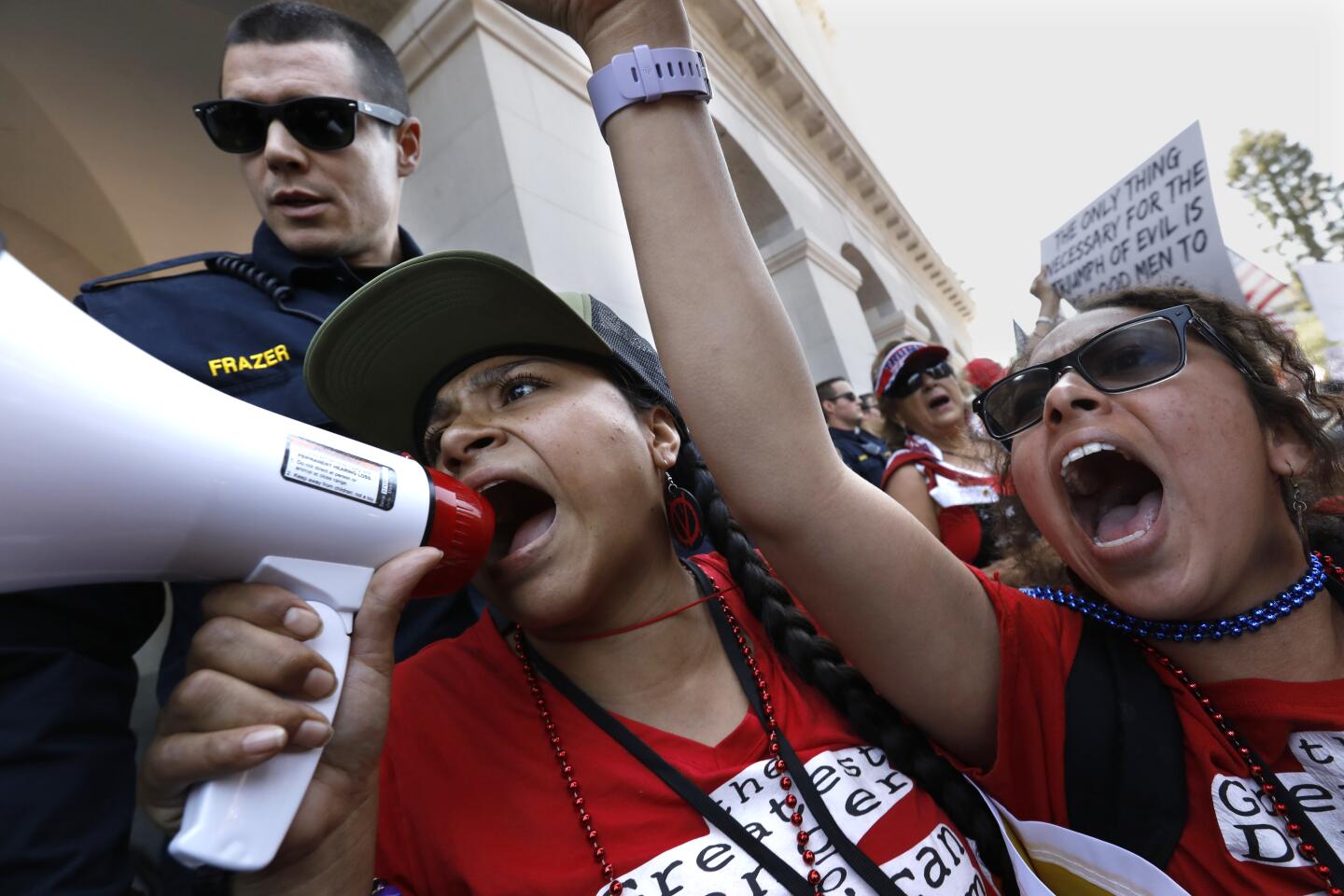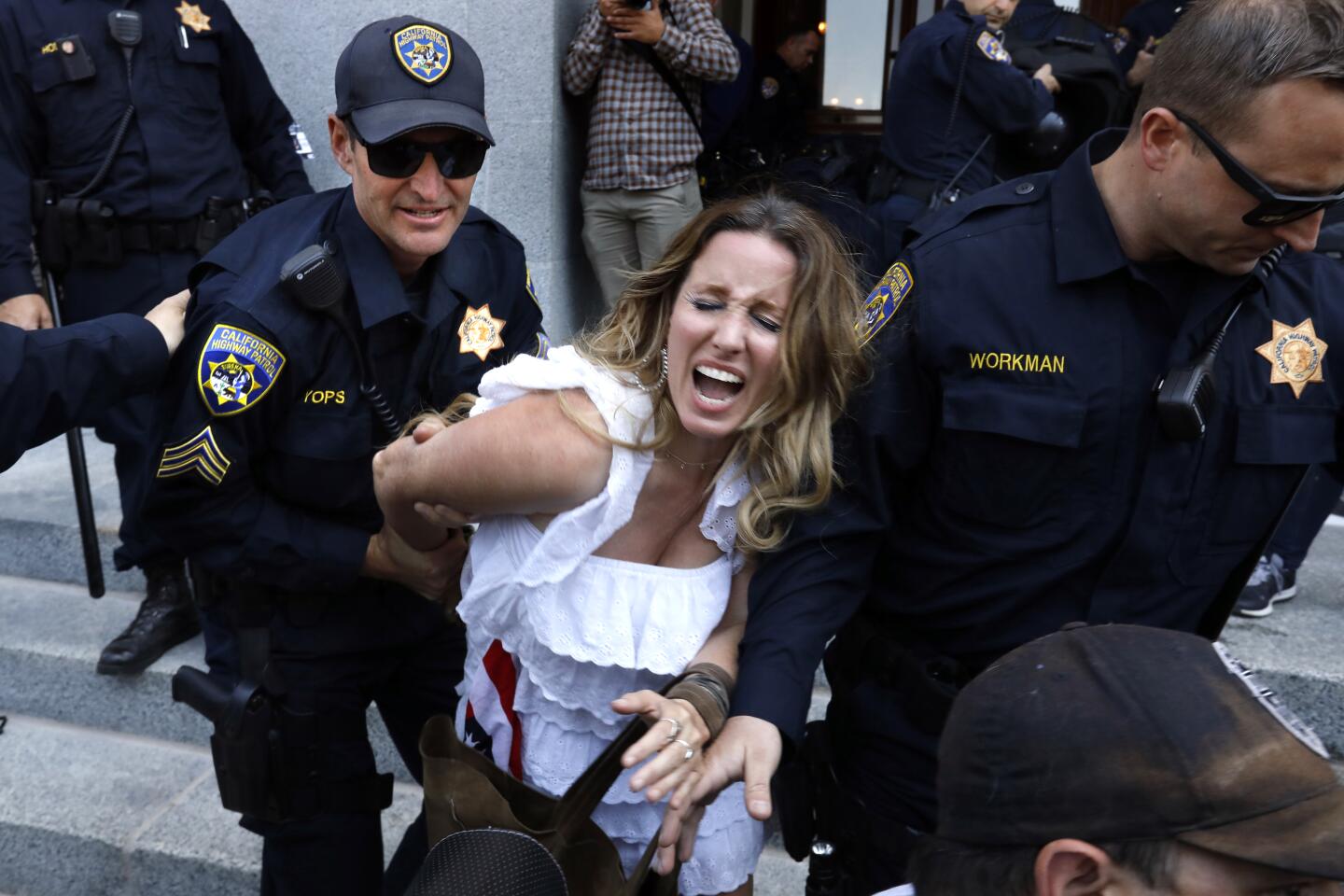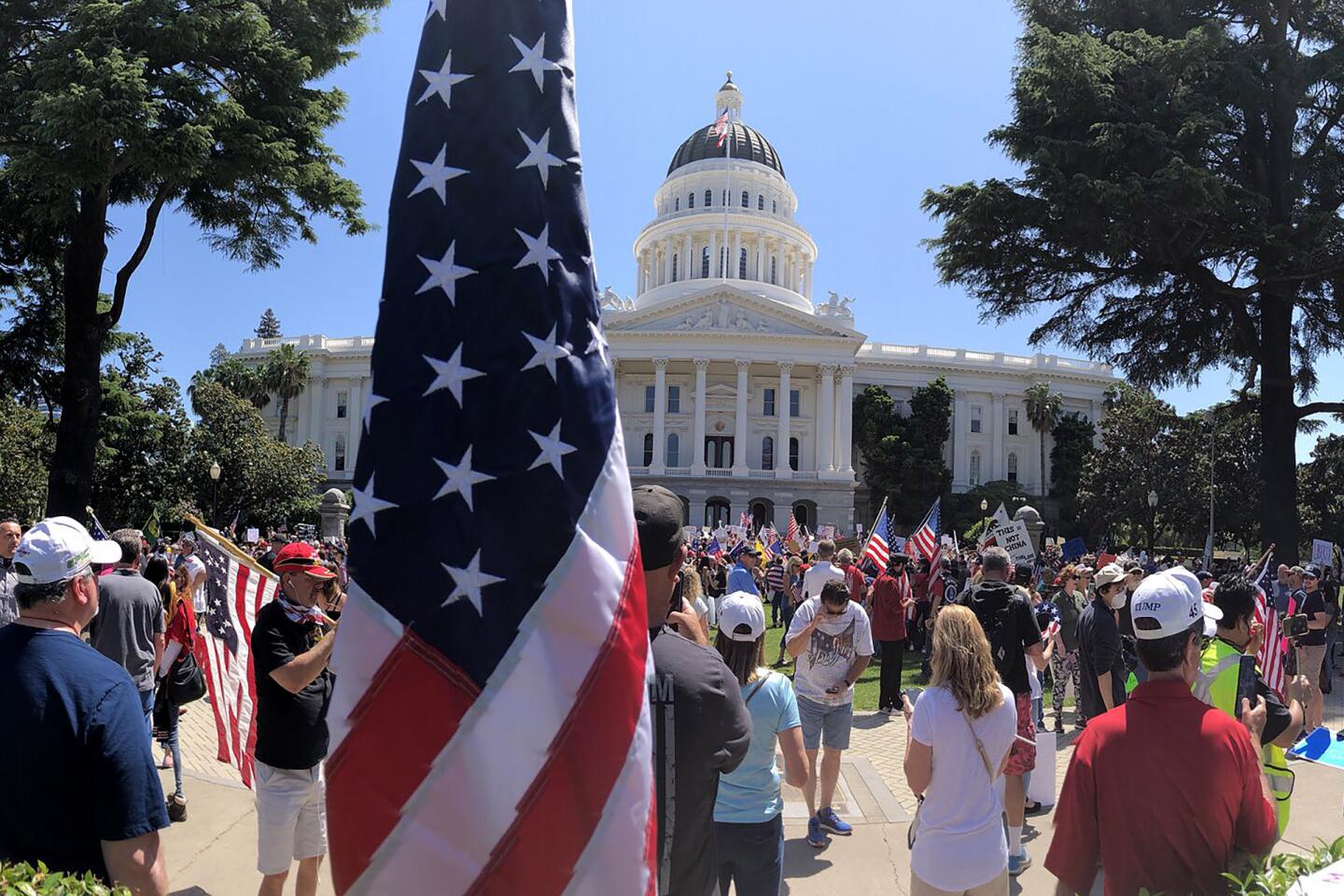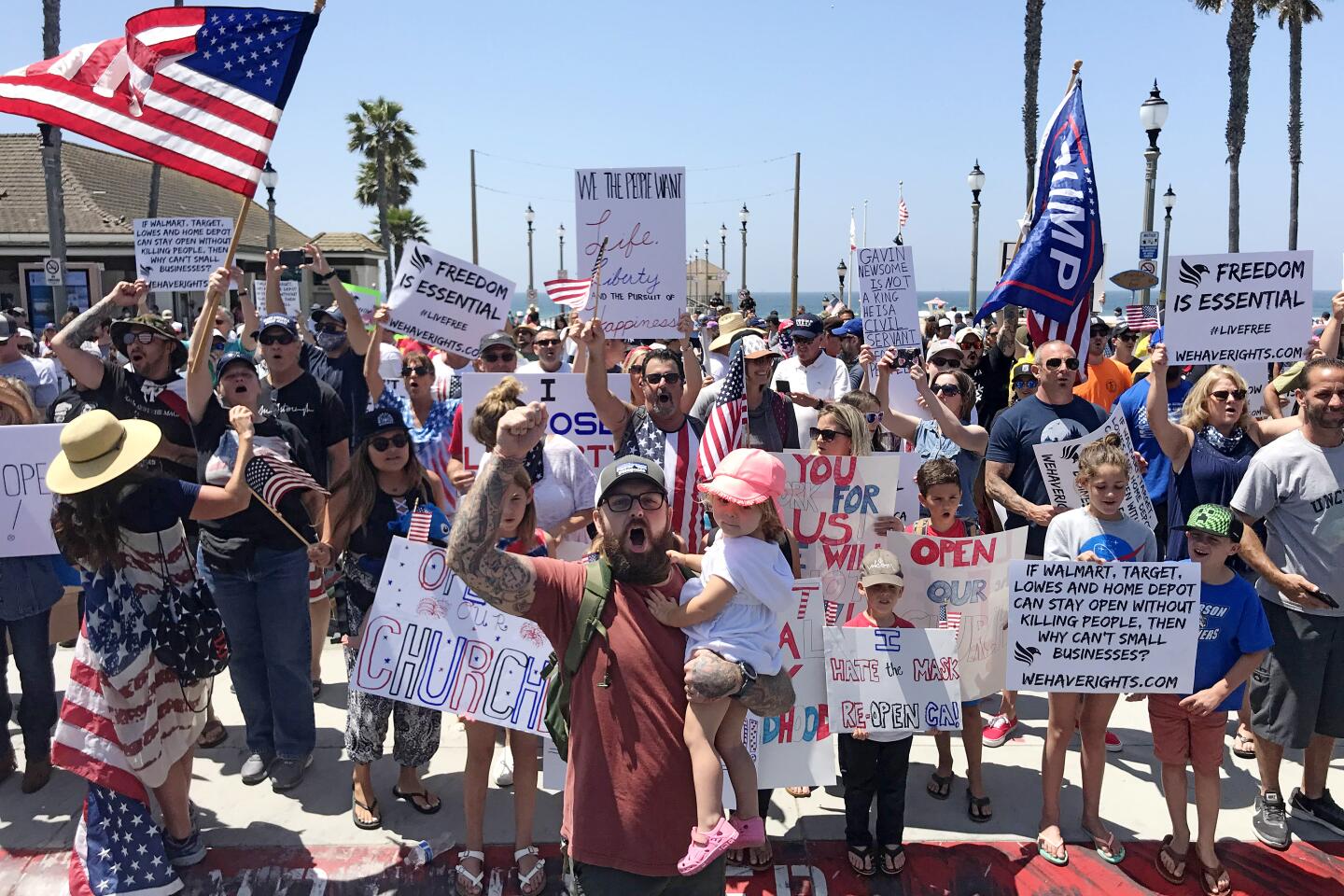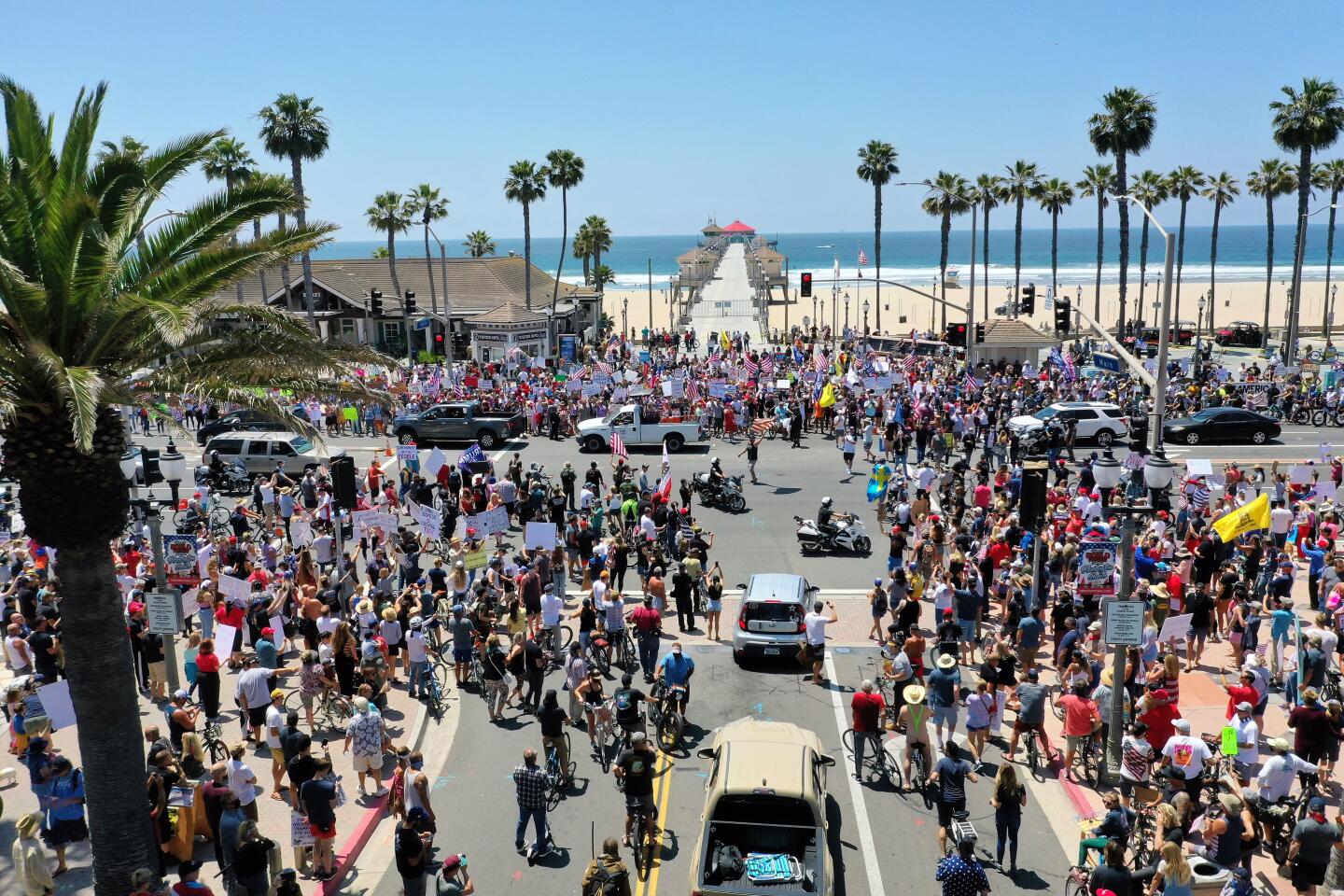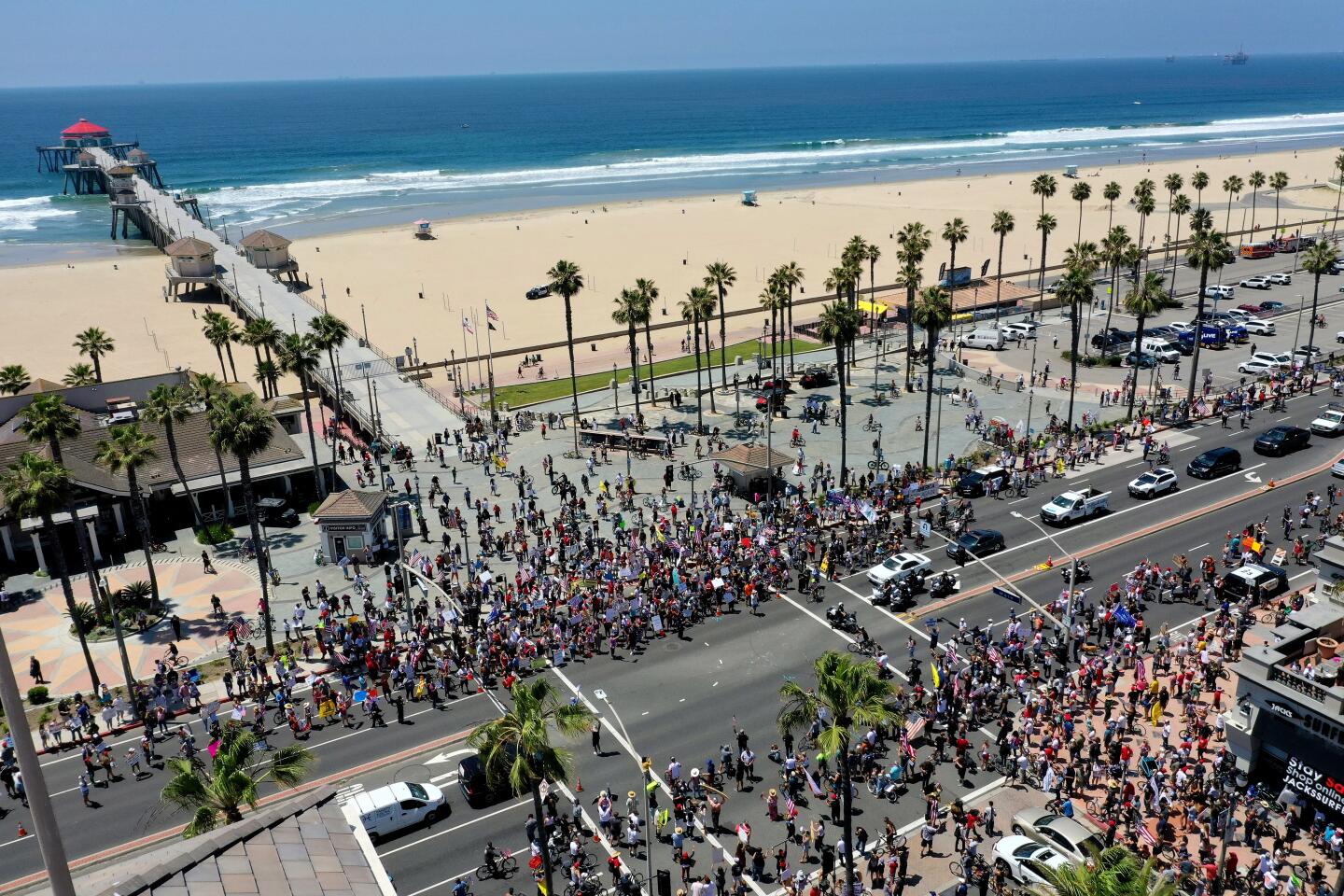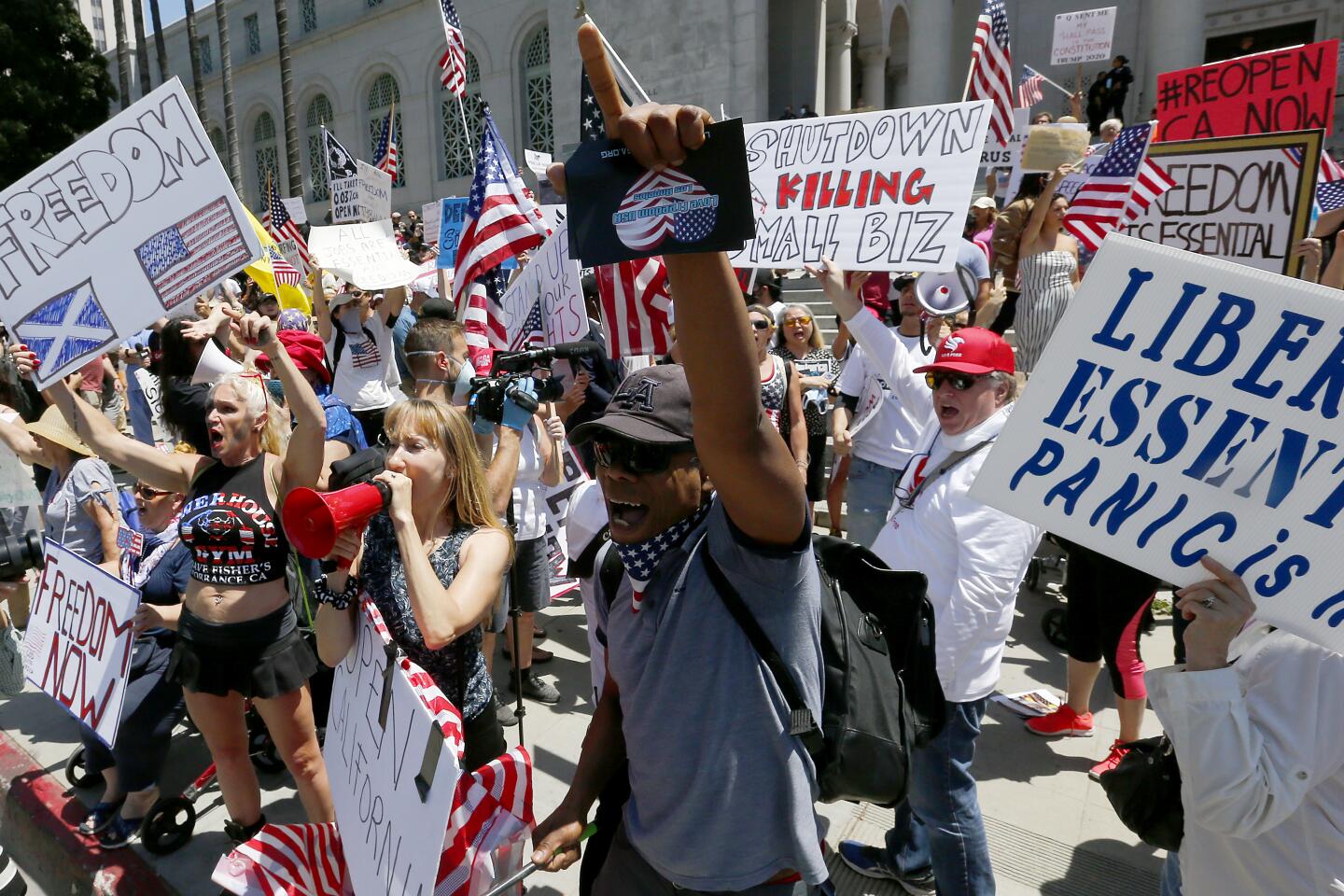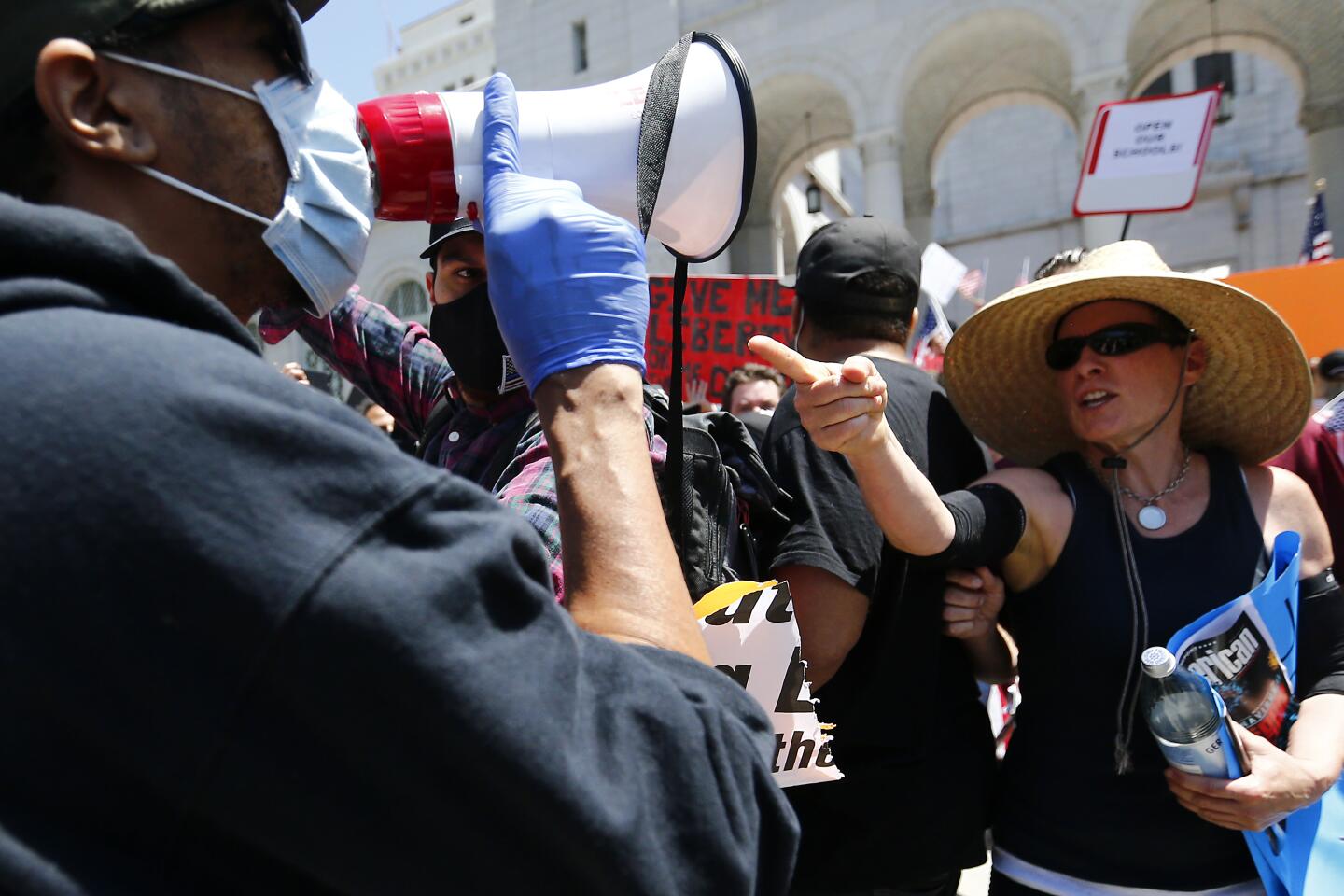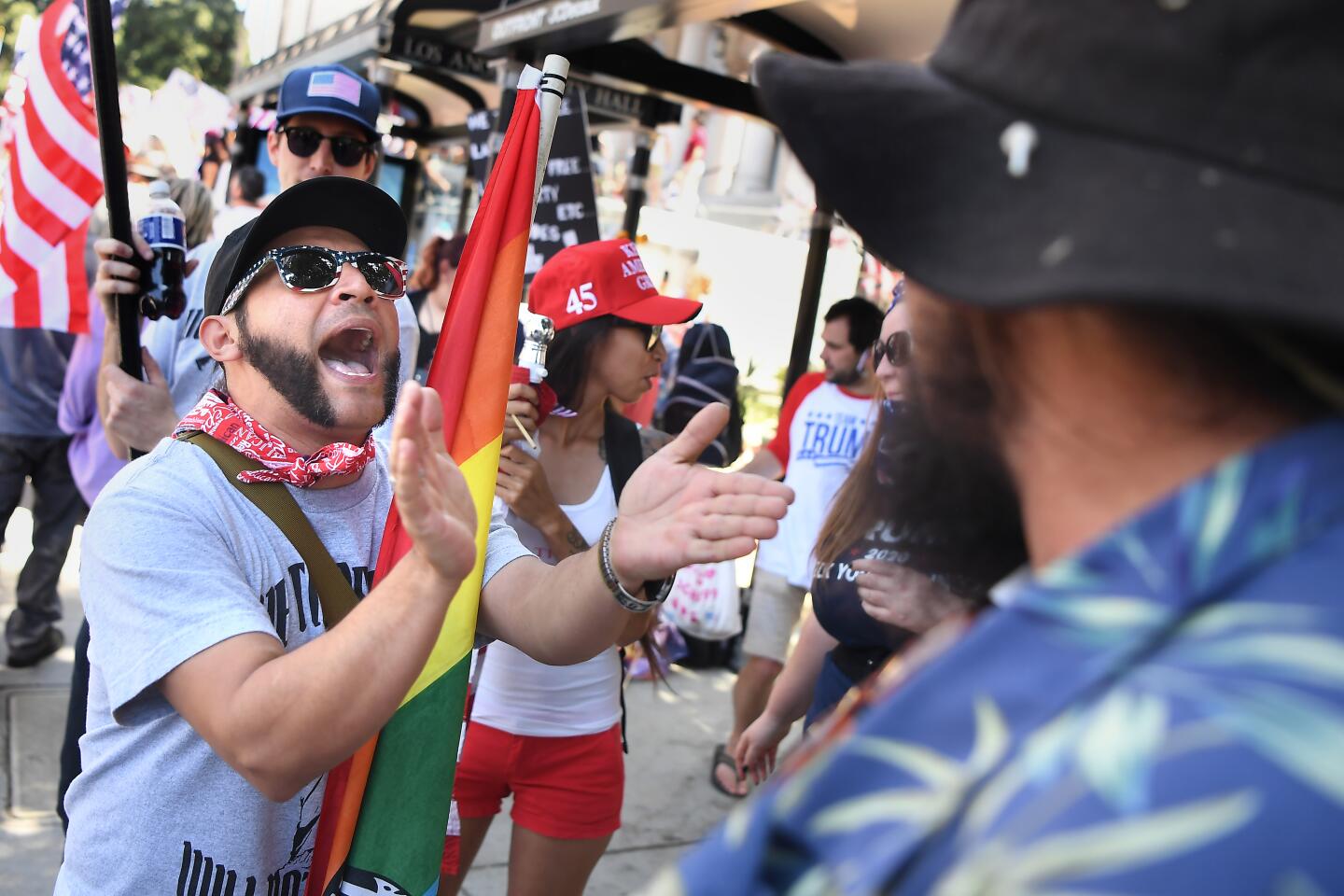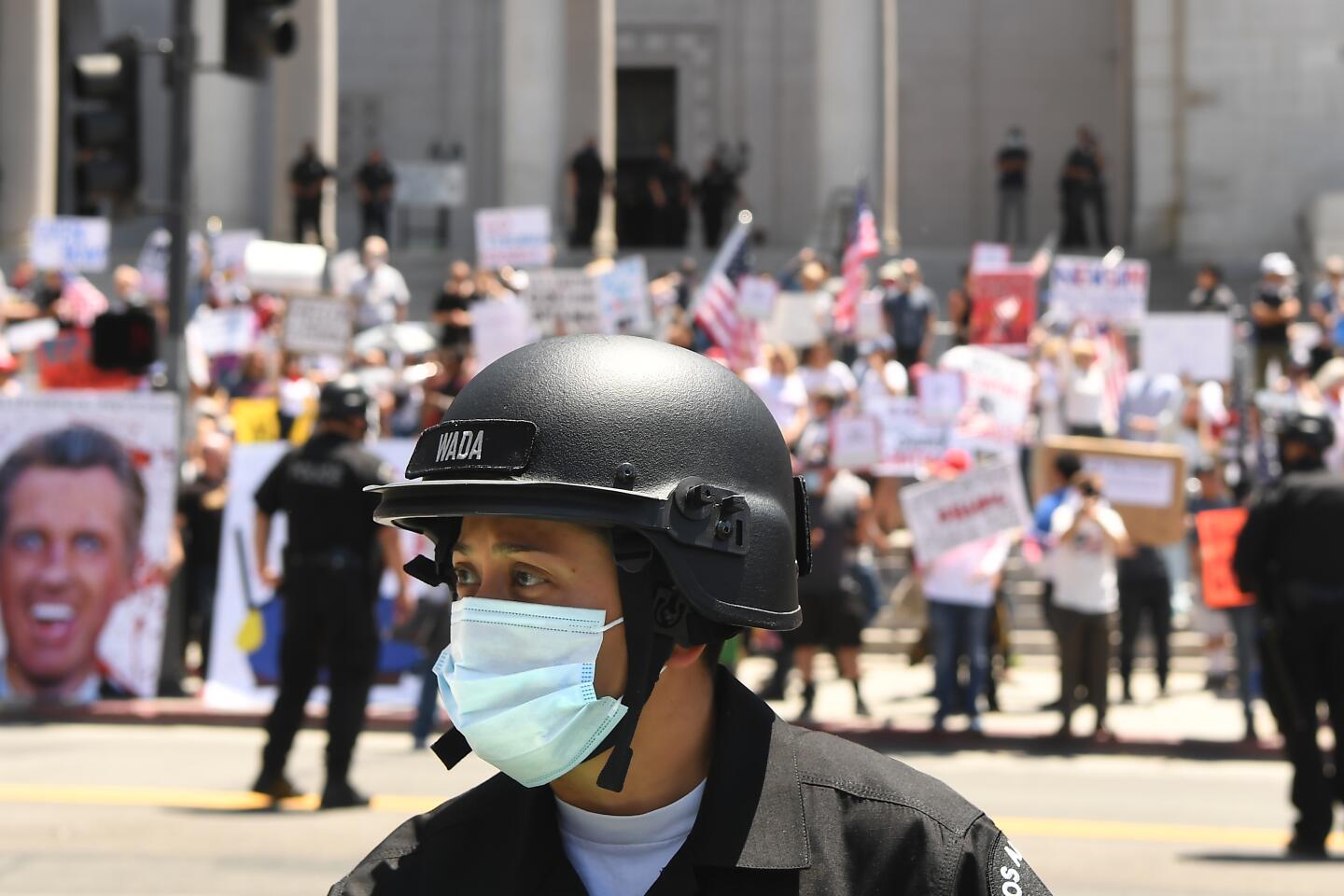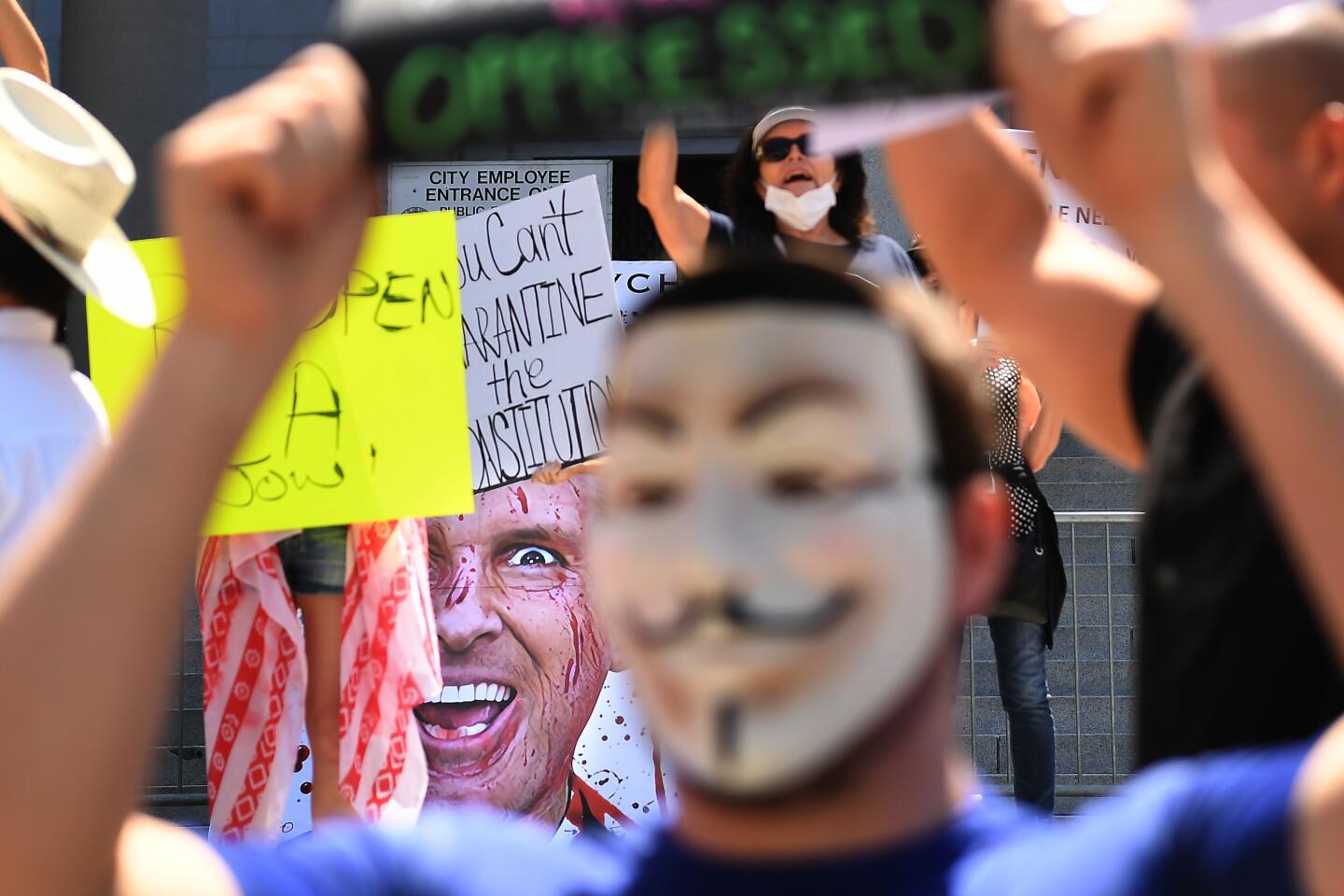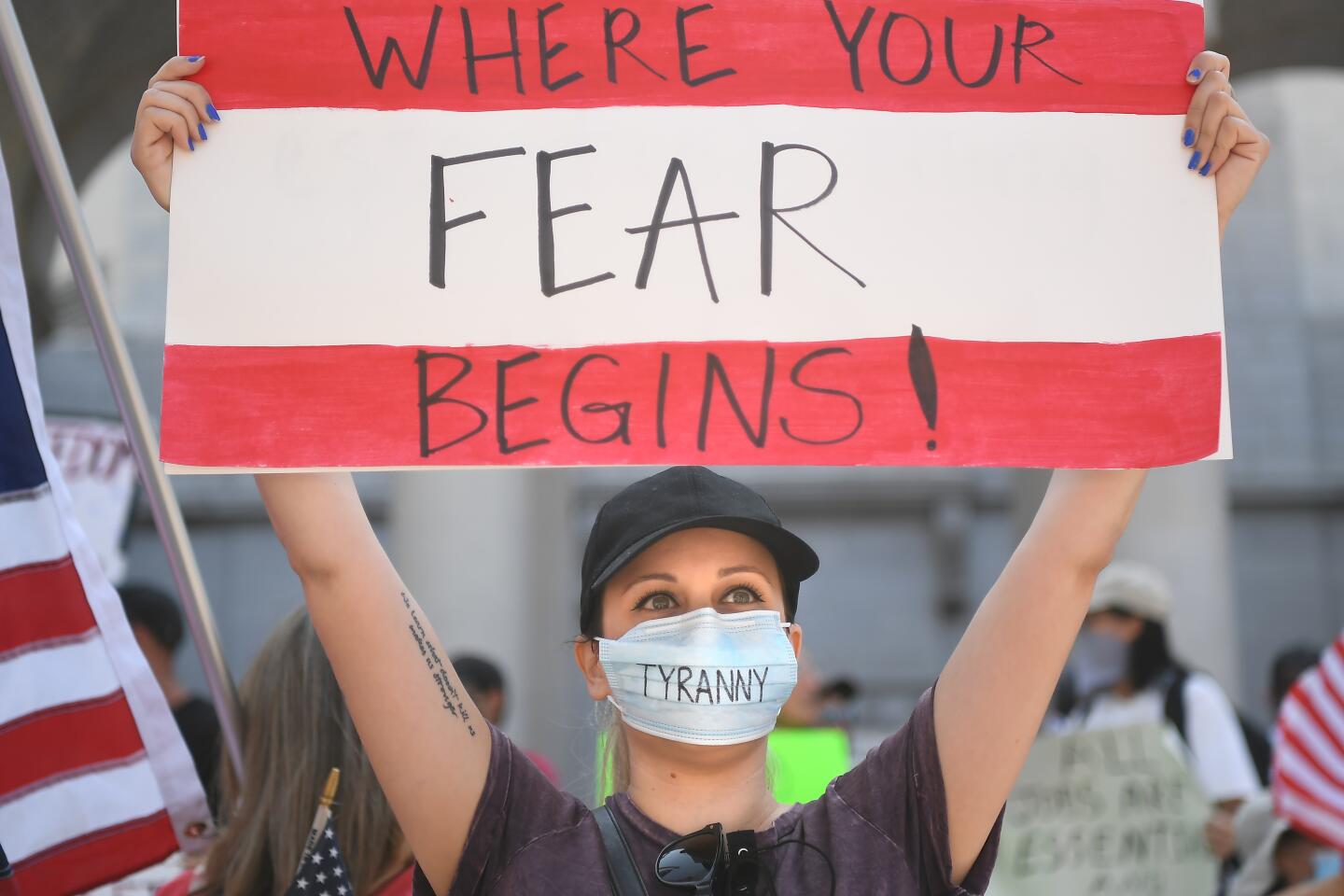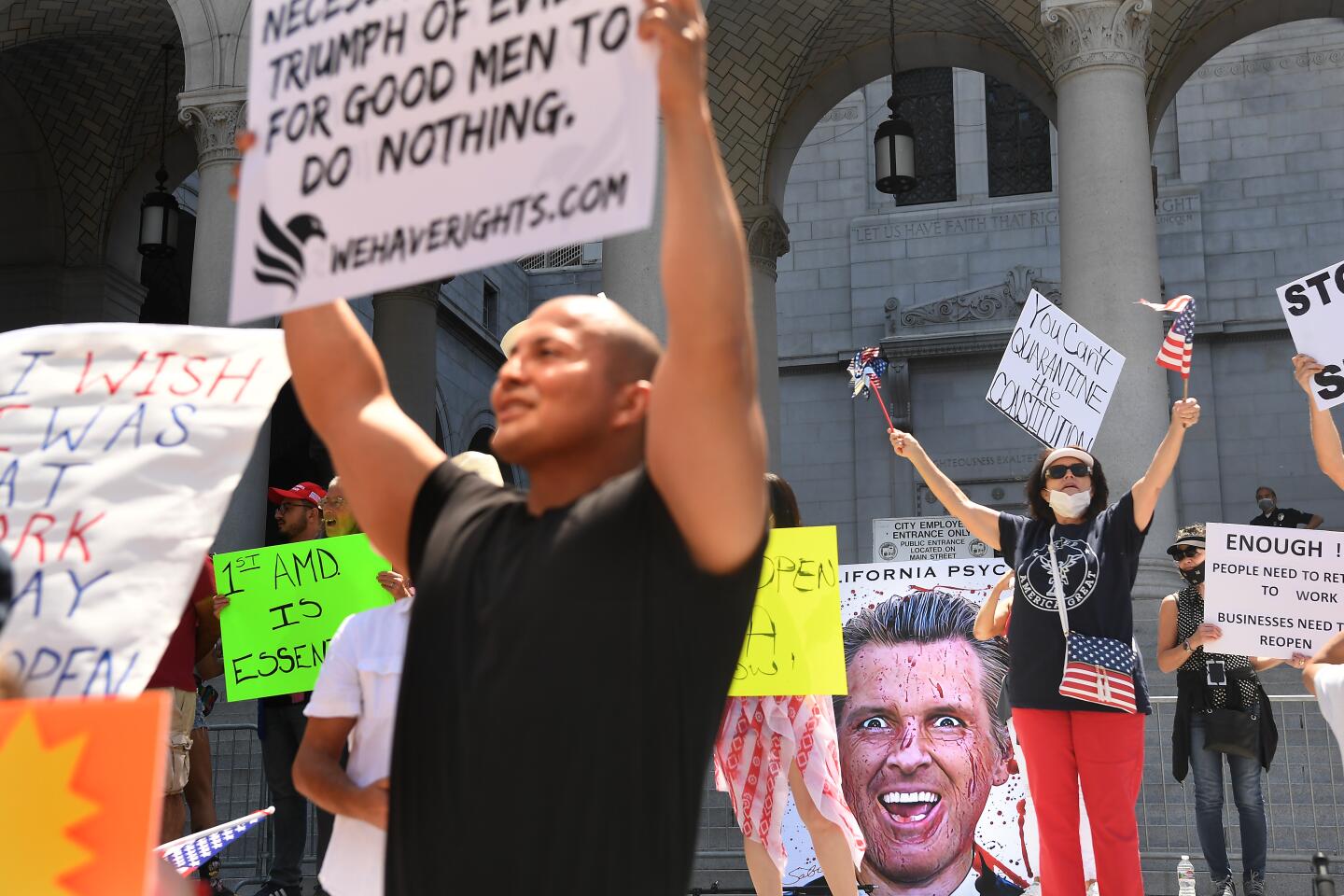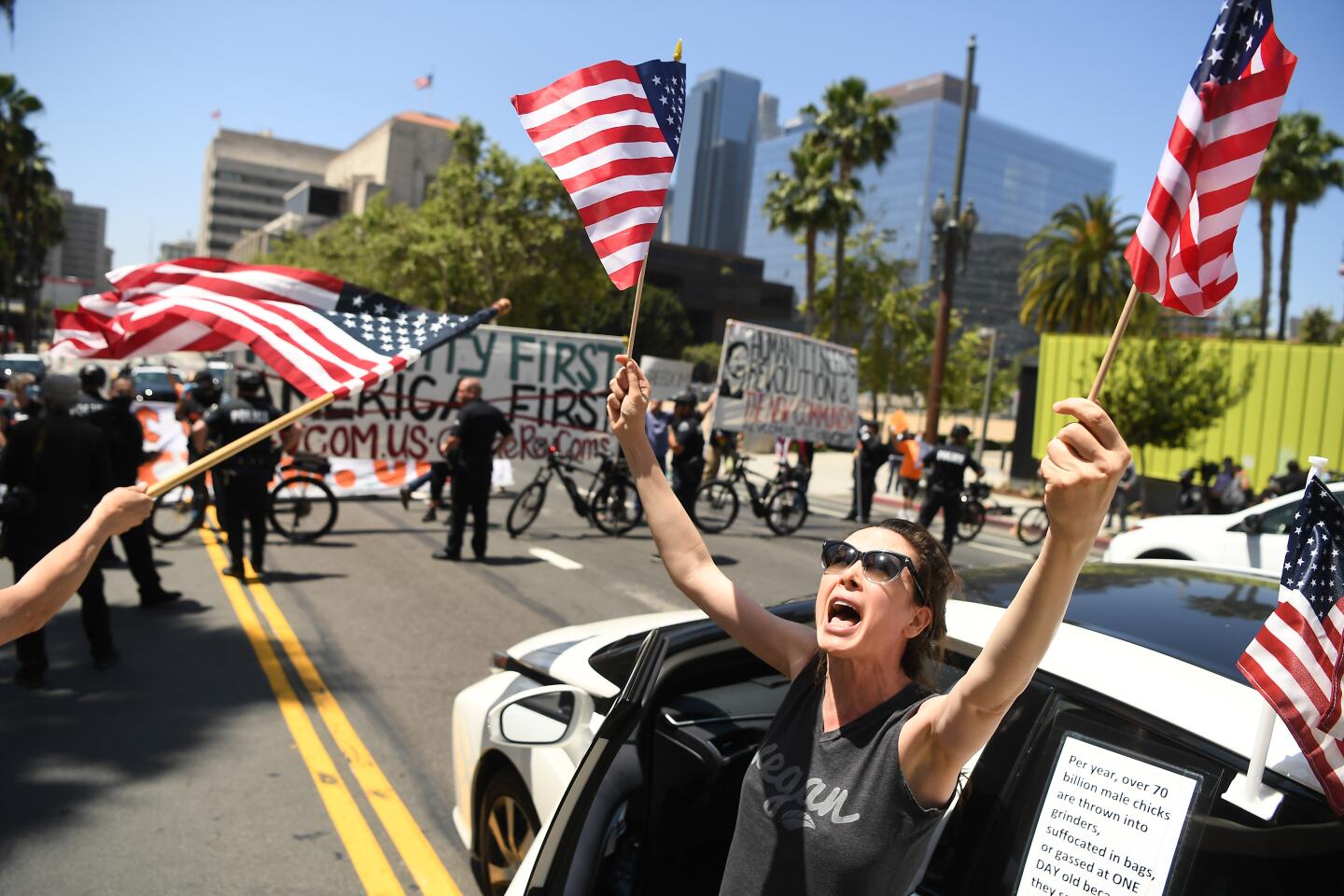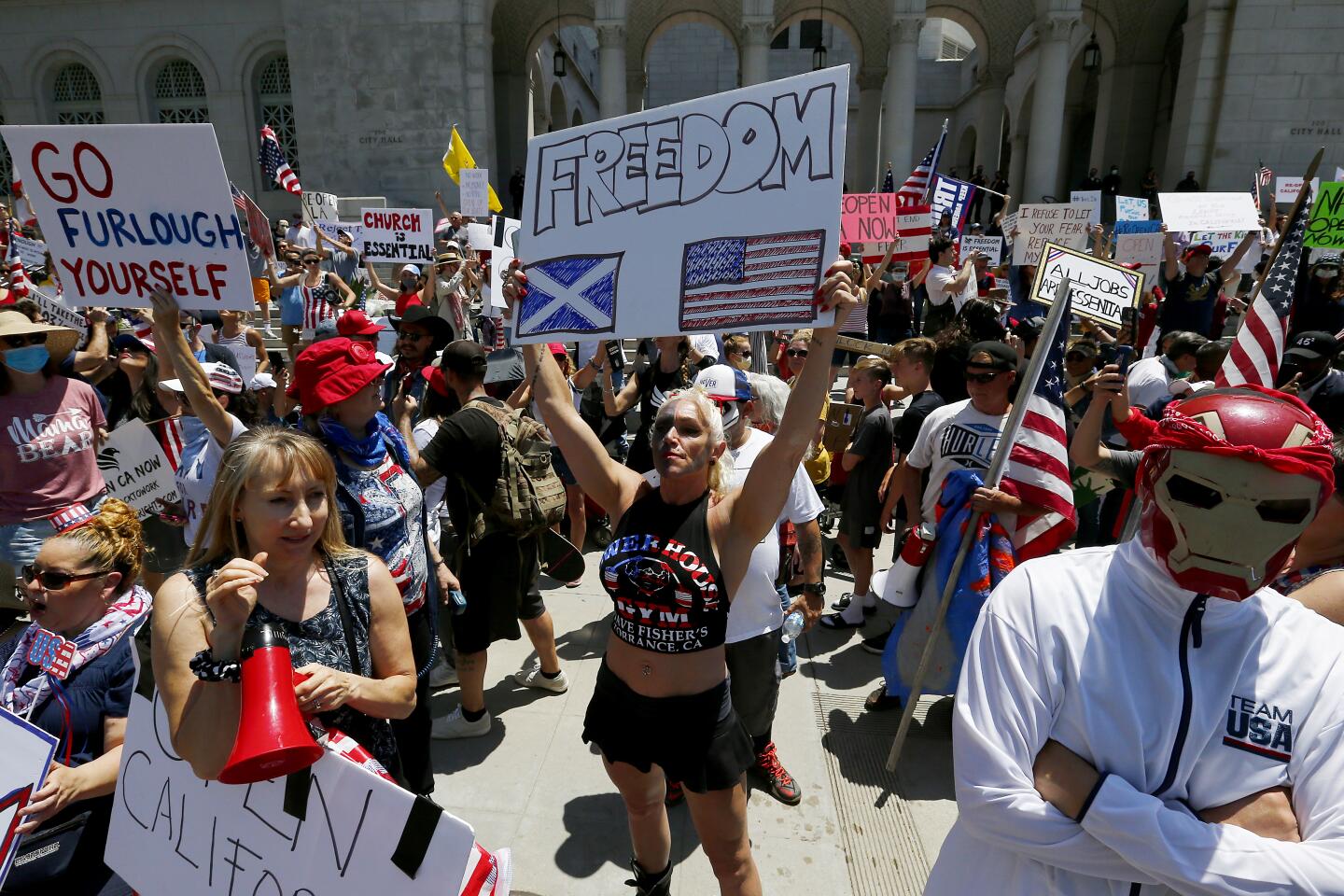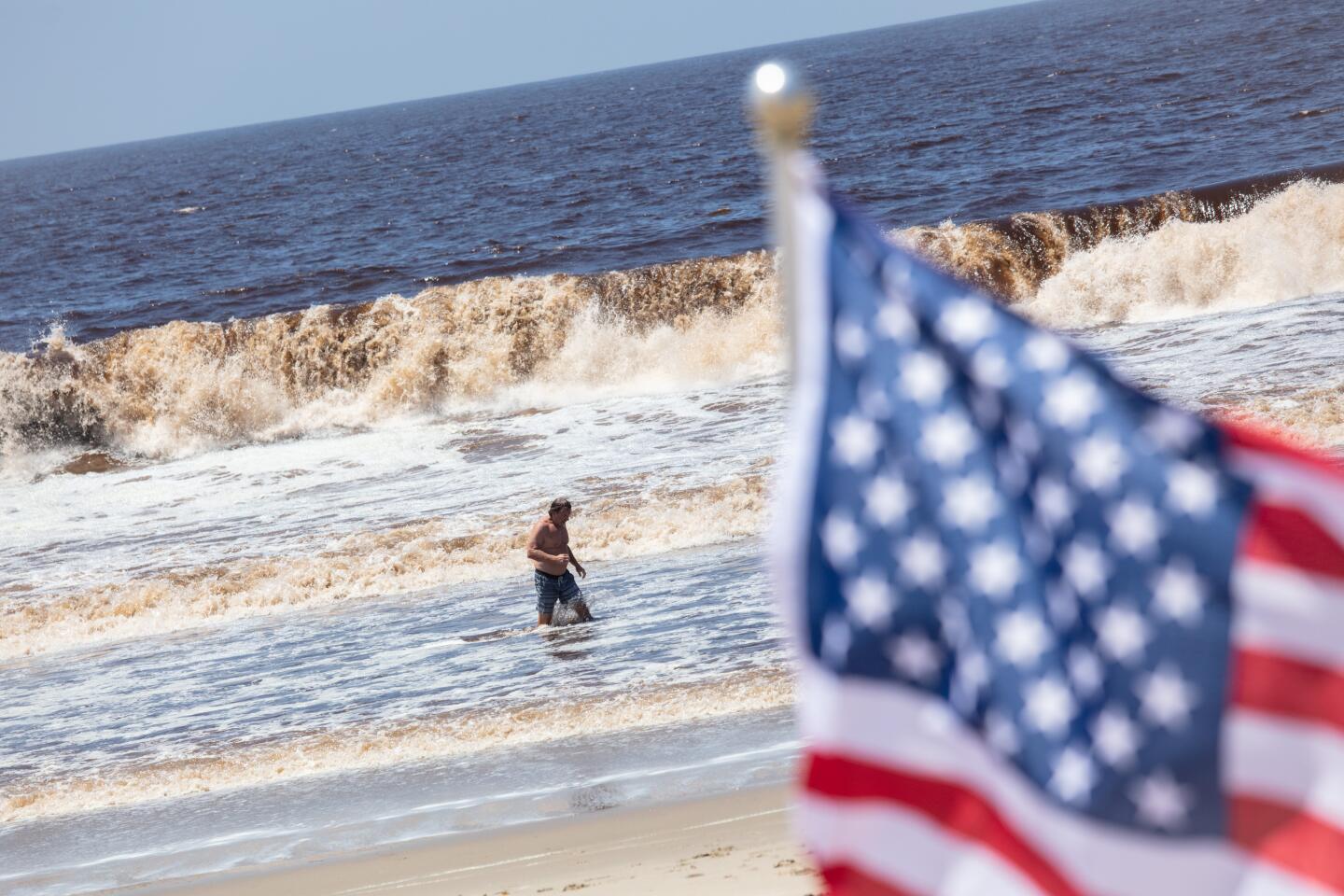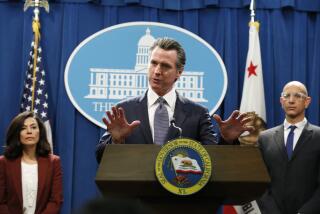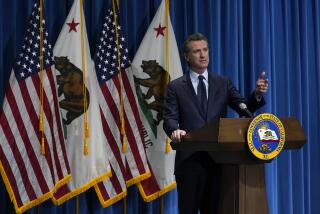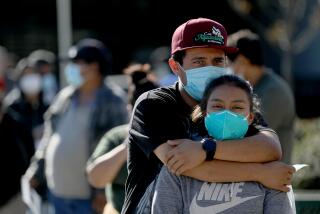Facing protests, Newsom says easing stay-at-home rules could be ‘days’ away

- Share via
Gov. Gavin Newsom on Friday faced the most intense pressure yet to lift restrictions on daily life, with a series of raucous protests around the state, a legal tussle with Orange County over closing its beaches and a rural Northern California county that defied his stay-at-home order and opened up for business.
While polls have shown Californians overwhelmingly support the governor’s efforts to slow the spread of the novel coronavirus, the growing economic carnage is becoming a potential political issue, especially in areas where COVID-19 has not spread rapidly.
On Friday, the governor acknowledged the frustrations and said he could make announcements within days about easing the state’s stay-at-home order, now in its sixth week.
This weekend could prove pivotal as officials try to slow the virus’ spread — especially in hard-hit Southern California — with hopes of cutting hospitalizations enough to begin easing the restrictions,
Newsom this week ordered the temporary “hard close” of all state and city beaches in Orange County to avoid a repeat of last weekend, when thousands of people flocked to the shoreline. He said Friday that “if we have the kind of weekend that I hope and expect we will,” he could be announcing new strategies as early as Monday.
“The only thing — I mean it — the only thing that’s going to hold us back is the spread of this virus,” Newsom said. “And the only thing that is assured to advance the spread of the virus is thousands of people congregating together, not practicing social distancing or physical distancing.”
As of Friday, there were at least 51,775 confirmed cases of COVID-19 in the state and 2,111 deaths.
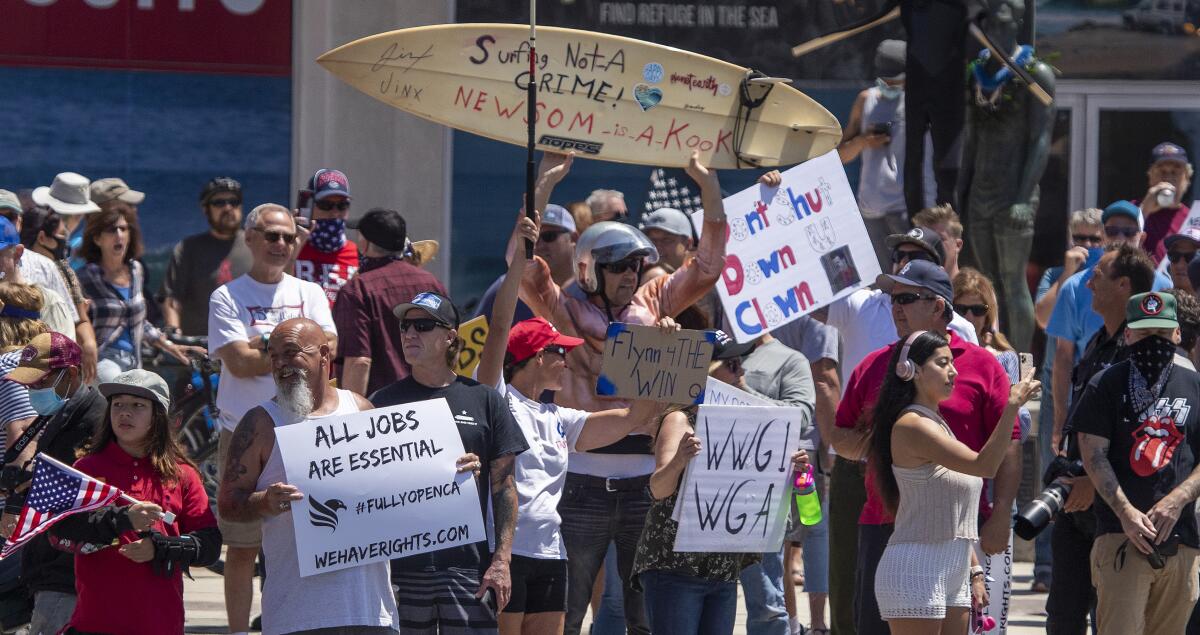
California was the first to impose a stay-at-home order, and experts credit that with helping the state see a fraction of the deaths of other coronavirus hot spots such as New York, New Jersey and Michigan. Officials in some bigger cities such as Los Angeles, San Jose and San Francisco have urged caution about reopening too early, fearing it could cause new outbreaks and hurt the economy more in the long run.
The biggest concern is in Los Angeles County, a hotbed of the coronavirus crisis in California. The county has recorded more than 1,000 deaths, nearly 25,000 confirmed cases and is home to about half of hospitalizations in the state.
Newsom’s squabbles with local officials over their abilities to determine what is safest for their respective communities have spiraled into more heated debates over the governor’s use of his executive powers to protect public health.
Legal battles are brewing in Orange County, where city leaders in Dana Point and Huntington Beach voted during emergency meetings Thursday night to approve filing for an injunction to block Newsom’s directive to close their beaches. The Newport Beach City Council plans to meet over the weekend to discuss legal options to challenge the closure.
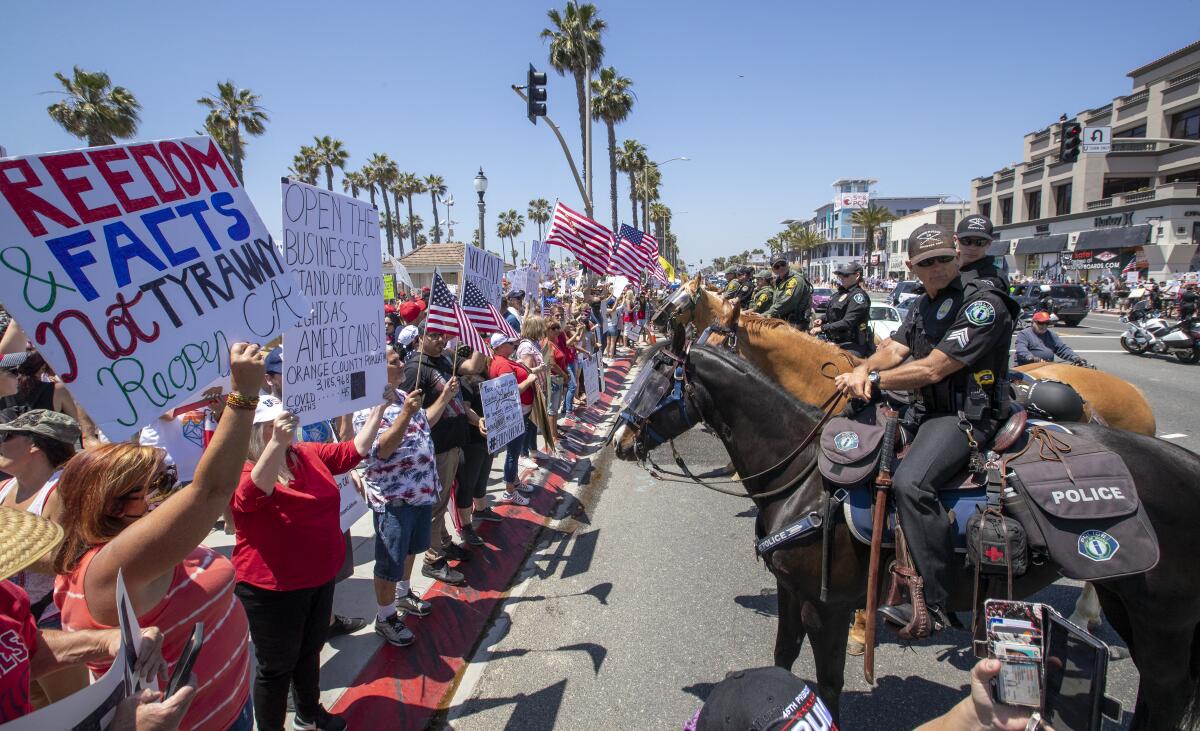
On Friday afternoon, Orange County Superior Court Judge Nathan Scott rejected a request from Huntington Beach seeking a temporary restraining order to keep beaches open. He set a hearing for May 11 to consider the city’s request for an injunction.
Orange County Sheriff Don Barnes said his department did not plan to cite people simply getting out for beach exercise. He said most beachgoers have acted responsibly.
“As long as people are social distancing and doing what they’re expected to do, the sheriff does not have interest in criminalizing people enjoying the beach,” department spokeswoman Carrie Braun said.
Judge refuses to block Newsom’s order closing Orange County beaches
Newport Beach will increase its police presence on the beach and roll out barricades and electronic signs to make sure people are aware of the closure, officials said. The Huntington Beach Police Department also said its officers were seeking “voluntary compliance” from the public.
More than 500 protesters descended on the intersection of Pacific Coast Highway and Main Street in Huntington Beach on Friday to decry the beach closures and demand stay-at-home orders be lifted. The densely packed crowd lined both sides of the street. Few wore masks.
“Hey, hey! Ho, ho! Newsom has gotta go!” they chanted.
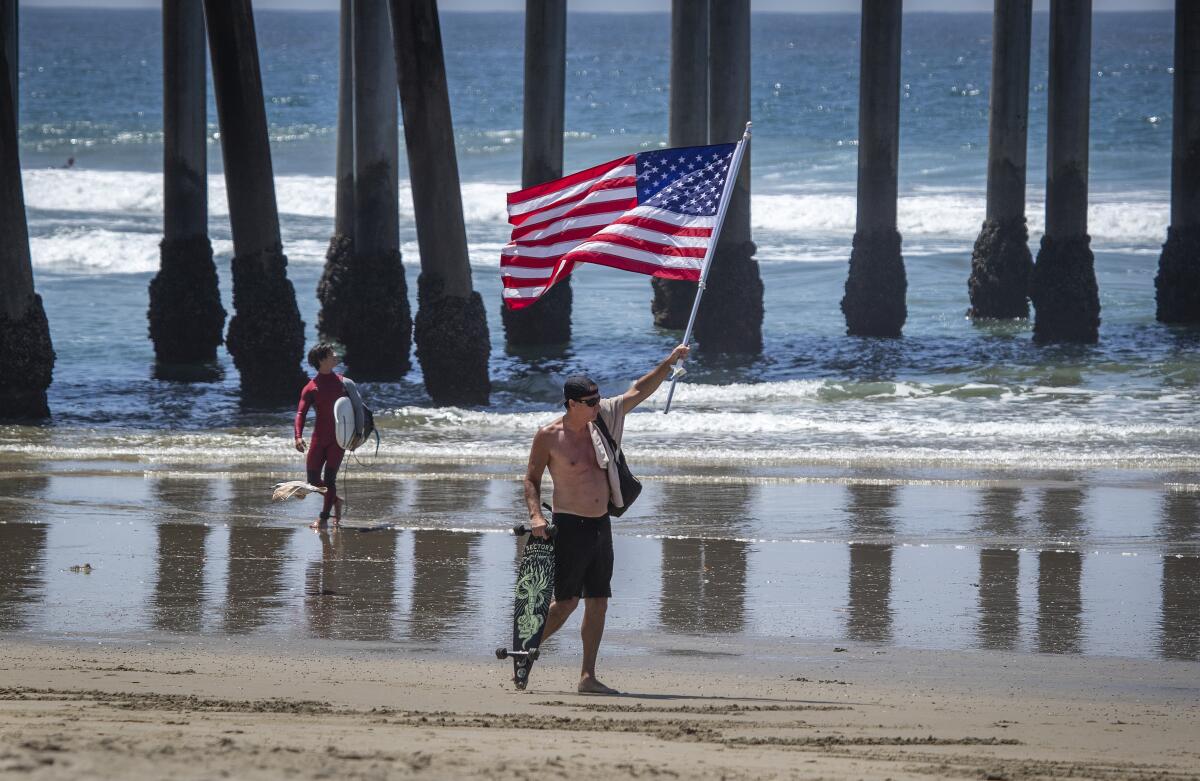
Andrew Norman — clad in board shorts, a black ball cap and sandals without a mask — equated his participation in Friday’s protest with his past time in the military.
“I served in the Army and fought tyrants and dictators overseas, and this has gone too far,” he said of Newsom’s stay-at-home order. “I didn’t do that to come back here and live under a tyrant in my own country.”
The Hesperia resident became aware of the protest through a social media campaign, #reopencalifornia, and made the 90-minute drive with his wife and three children, ages 7 to 11.
Tami Avants, 60, of Rancho Cucamonga, said she lost her job as a hairdresser and is looking to get back to work.
The governor ordered Orange County beaches closed Thursday despite opposition from local leaders who argue they should decide whether it’s safe to hit the sand.
She likened the recent $1,200 checks from the government as welfare and said she wants to earn her own money again.
Just steps away from the protest, beachgoers lounged in the sand and frolicked in the waves.
Hundreds of protesters also gathered outside the closed California State Capitol building in Sacramento. Scores more circled the block, protesting from their cars.
Horns blared. Cow bells rang. Nary a mask was in sight, though there was plenty of Trump 2020 gear. Overhead, a plane circled, trailing a banner with Newsom’s photo and the words, “End His Tyranny.”

Leigh Dundas, a human rights lawyer from Los Angeles, stood in an American flag-covered speedboat parked on the street, railing against the closure of Orange County beaches.
“What’s going on at this point is unconstitutional,” Dundas said.
“Freedom!” shouted people around her.
Meanwhile, in the northeast corner of the state, rural Modoc County became the first in the state to ease stay-at-home rules Friday, despite Newsom’s urging to keep them in place.
Protesters in Sacramento urge Gov. Newsom to reopen California
The county, which has fewer than 9,000 residents, was one of four in California that had not reported a single confirmed case of COVID-19 as of Friday. Officials announced that businesses, schools and churches may reopen, as long as people stay six feet apart.
“Our businesses are dying and people need to be able to feed their children and pay their rent,” said Heather Hadwick, deputy director of the county’s Office of Emergency Services. “We live a different life than the rest of California. We’re very rural and naturally socially distanced in our everyday lives.”
Restaurants and bars will be allowed to host diners, but only at half capacity. People 65 and older and residents with underlying health conditions will still be required to stay home except to conduct essential business, and large gatherings will still be banned.
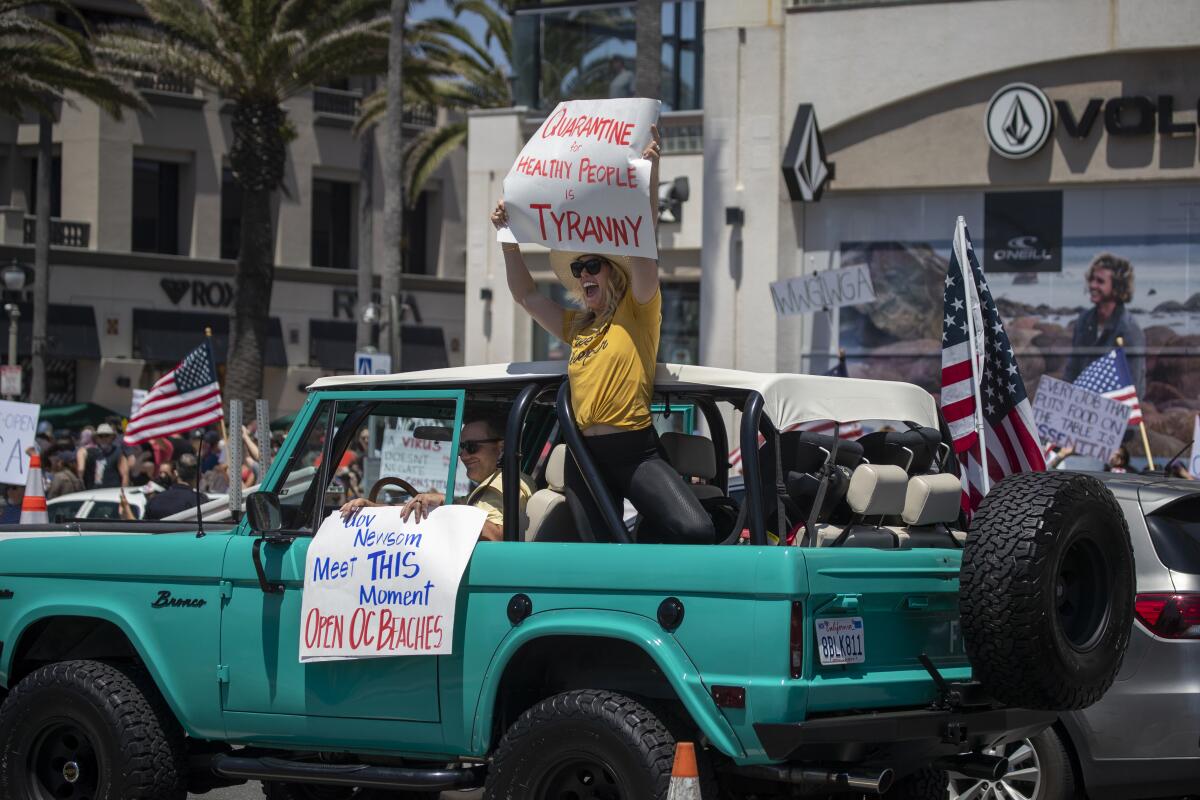
Restaurant owner Jodie Larranaga said employees were preparing to open Friday and sending out word to customers.
“My bar tables are already far apart. But if people pull their stools together, I’m not going to stop them,” said Larranaga, who owns the Brass Rail. “As far as I’m concerned, right or wrong, that’s their choice. They are adults.”
Not every institution that could reopen plans to do so, though.
Ken Entwistle, senior pastor of GracePoint Church of the Nazarene in Alturas, said the stance of the Nazarene denomination is to follow the state’s order — which means he’ll continue streaming services and devotionals via Facebook Live.

“We need to pay attention to the prompting of the spirit and we need to look toward our authorities for some answers or some OKs,” he said. “For us, Jesus Christ is the absolute authority.”
It’s not yet clear how the state will respond to Modoc’s move. The governor’s media office did not answer a request for comment Friday.
When it comes to matters of public health, the state has wide powers to enact regulations and restrictions, according to Julie Nice, a constitutional law professor at the University of San Francisco.
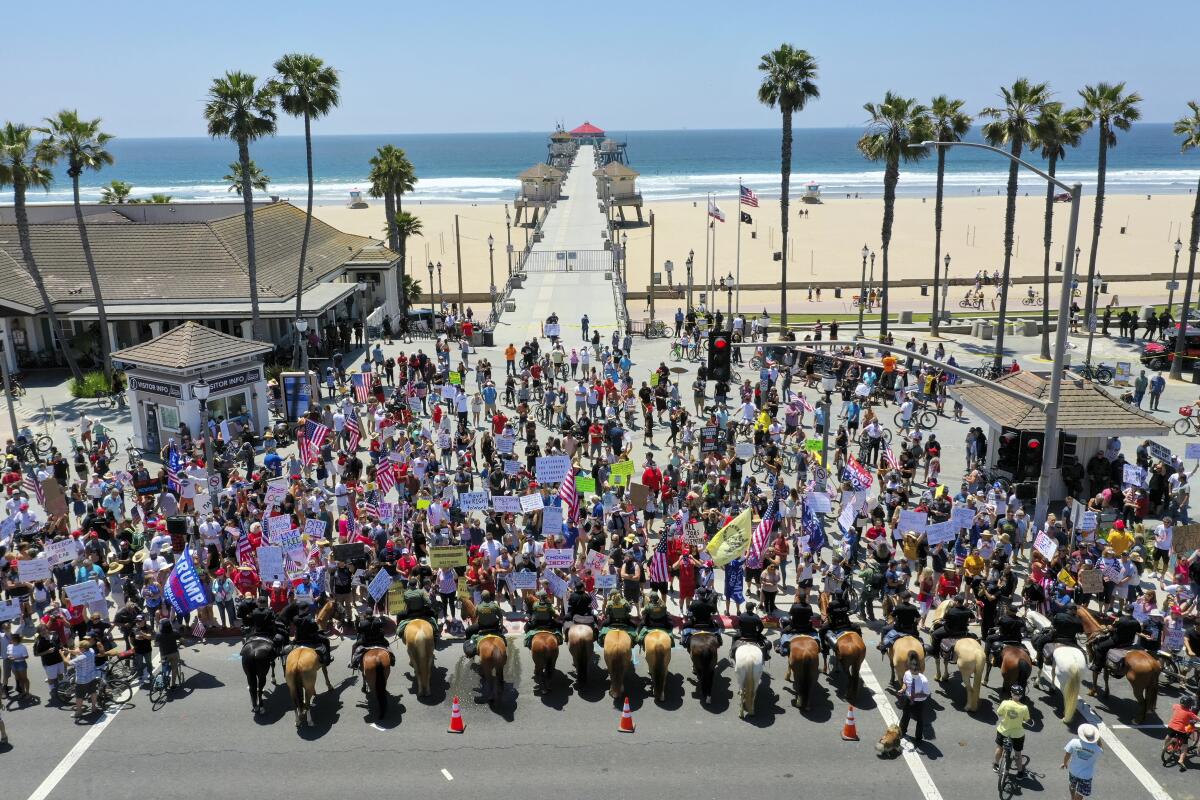
Counties and other local governments “may enforce health and safety and sanitation rules,” she said, “so long as they do not conflict with the state’s general law.” That doesn’t seem to be the case with what Modoc County has proposed, she said.
“From everything I can tell from the governor’s orders and what the county has said it plans to do, it appears to directly conflict with state law,” she said. “And I think, as a matter of governmental power, the county’s likely to lose against the state.”
Elected officials from across rural California — from the Central Coast to the Central Valley, Northern California and elsewhere — have asked Newsom to let them ease restrictions, arguing that their infection rates are incomparable to hot spots such as Los Angeles County.
Newsom on Friday said he wanted to “be crystal clear” that he understood there were different circumstances in rural areas and that the state was in direct contact with local leaders in those places.
“We hear you,” he said. “We’re paying attention to you.”
Times staff writers Anh Do, Priscella Vega, Alex Wigglesworth, Hannah Fry and Rong-Gong Lin II and the Associated Press contributed to this report.

More to Read
Sign up for Essential California
The most important California stories and recommendations in your inbox every morning.
You may occasionally receive promotional content from the Los Angeles Times.
